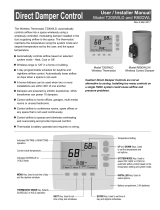FLEXYII_WSHP-IOM-1307-E - 13 -
WATER SOURCE HEAT PUMP ONLY
Water connections
The water circulating pump will be preferably installed upstream so that the evaporator/condenser will be subjected to positive
pressure. Inlet and Outlet water connections are indicated on the certified drawing sent with the unit or shown in the sales
brochure.
The water pipes connected to the unit must not transmit any radial or axial force or any vibration to the heat exchangers.
It is important to follow non exhaustive recommendations hereunder:
• Comply with the water inlet and outlet connections shown on the unit.
• Install manual or automatic air purge valves at all high points in the circuit.
• Install a safety valve as well as an expansion tank to maintain the circuit pressure.
• Install thermometers in both the inlet and outlet water connections.
• Install drain connections at all low points to allow the whole circuit to be drained.
• Install stop valves, close to the inlet and outlet water connections.
• Use flexible connections to reduce vibrations transmission.
• After testing for leaks, insulate all pipe work, to reduce thermal leaks and to prevent condensation.
• If the external water pipes are in an area, where the ambient temperature is likely to fall below 0°C, insulate the piping and
add an electric heater.
• Ensure full earthling continuity
A drainage plug is located at the base of the evaporator. A drainage pipe may be connected to this to enable drainage of
evaporator water for service operations or for seasonal shut down.
Connections at the inlet and outlet are Victaulic type.
Water analysis
The water must be analysed; the water circuit installed must include all items necessary for water treatment: filters, additives,
intermediate exchangers, bleed valves, vents, isolating valves etc... depending on the results of the water analysis.
We do not advise operation of the units with open loops which can cause troubles with oxygenation, or
operation with untreated ground water.
Use of untreated or improperly treated water can cause deposits of scale, algae and sludge or cause corrosion and erosion. It is
advisable to call in a qualified water treatment specialist to determine what kind of treatment will be necessary. The
manufacturer cannot accept liability for damage caused by the use of untreated or improperly treated water, salt water or brine.
Here are our non exhaustive recommendations given as an indication:
• No NH4+ ammonium ions in the water, they are very detrimental for copper. <10mg/l
• Cl- Chloride ions are detrimental for copper with a risk of perforations by corrosion by puncture. < 10 mg/l.
• SO42- sulphate ions can cause perforating corrosion.< 30 mg/l.
• No fluoride ions (<0.1 mg/l).
• No Fe2+ and Fe3+ ions with dissolved oxygen. Dissolved iron < 5 mg/l with dissolved oxygen < 5 mg/l. Over
those values, it means a corrosion of steel which may generate a corrosion of copper parts under deposite of Fe – this is
mainly the case with shell and tube heat exchangers.
• Dissolved silicon: silicon is an acid element of water and can also lead to corrosion risks. Content < 1mg/l.
• Water hardness: TH >2.8 K. Values between 10 and 25 can be recommended. This will facilitate scale deposit that can limit
corrosion of copper. TH values that are too high can cause piping blockage over time.
• TAC< 100.
• Dissolved oxygen: Any sudden change in water oxygenation conditions must be avoided. It is as detrimental to
deoxygenate the water by mixing it with inert gas as it is to over-oxygenate it by mixing it with pure oxygen. The disturbance
of the oxygenation conditions encourages destabilisation of copper hydroxides and enlargement of particles.
• Specific resistance – electric conductivity: the higher the specific resistance, the slower the corrosion tendency. Values
above 3000 Ohm/cm are desirable. A neutral environment favours maximum specific resistance values.
For electric conductivity values in the order of 200-6000 S/cm can be recommended.
• pH: pH neutral at 20°C (7 < pH < 8)





















